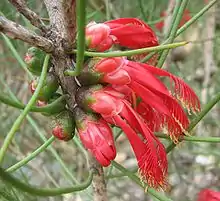Calothamnus gilesii
Calothamnus gilesii is a plant in the myrtle family, Myrtaceae and is endemic to the south-west of Western Australia. It is an erect, usually compact shrub with fine, pine-like foliage and which produces cluster of red flowers from June to January. (In 2014 Craven, Edwards and Cowley proposed that the species be renamed Melaleuca gilesii.)[2]
| Calothamnus gilesii | |
|---|---|
 | |
| Calothamnus gilesii in the Royal Botanic Gardens, Cranbourne | |
| Scientific classification | |
| Kingdom: | Plantae |
| Clade: | Tracheophytes |
| Clade: | Angiosperms |
| Clade: | Eudicots |
| Clade: | Rosids |
| Order: | Myrtales |
| Family: | Myrtaceae |
| Genus: | Calothamnus |
| Species: | C. gilesii |
| Binomial name | |
| Calothamnus gilesii | |
| Synonyms | |
Description
Calothamnus gilesii is an erect, or open, spreading shrub growing to a height of about 1.5 metres (4.9 ft). Its leaves are fine, circular in cross section and up to 120 millimetres (5 in) long tapering to a sharp point.[3][4]
The flowers are bright red and arranged in small groups. The stamens are arranged in 5 claw-like bundles. Flowering occurs in late spring and summer and is followed by fruits which are woody capsules.[3][4]
.JPG.webp)
.JPG.webp)
Taxonomy and naming
Calothamnus gilesii was first formally described by Victorian Government Botanist Ferdinand von Mueller in 1876 in the tenth volume of Fragmenta Phytographiae Australiae.[1][5] It is not clear whether the specific epithet (gilesii) honours Ernest Giles who conducted major expeditions in central Australia[6] or Ernest Giles's friend, Christopher Giles, both of whom made collections for Mueller.[7] Mueller noted that the collection was made by "Giles and Young".[5]
Distribution and habitat
Calothamnus gilesii is widespread in the drier areas of south-western Western Australia including the Avon Wheatbelt, Coolgardie, Geraldton Sandplains, Great Victoria Desert, Mallee, Murchison, Nullarbor Plain and Yalgoo biogeographic regions. It grows on sandplains and stony ridges.[8]
Conservation
This species is classified as "not threatened" by the Western Australian government department of parks and wildlife.[8]
Use in horticulture
In cultivation, the species adapts well to harsh, hot situations. It tolerates some dryness and moderate frost.[9]
References
- "Calothamnus gilesii". APNI. Retrieved 26 July 2015.
- Craven, Lyn A.; Edwards, Robert D.; Cowley, Kirsten J. (30 June 2014). "New combinations and names in Melaleuca (Myrtaceae)". Taxon. 63 (3): 665. doi:10.12705/633.38.
- Wrigley, John W.; Fagg, Murray (1983). Australian native plants : a manual for their propagation, cultivation and use in landscaping (2nd ed.). Sydney: Collins. p. 194. ISBN 0002165759.
- Phillips, Roger. "Calothamnus gilesii". Rogers Trees and Shrubs. Archived from the original on 4 March 2016. Retrieved 27 July 2015.
- von Mueller, Ferdinand (1876). Fragmenta Phytographiae Australiae (Volume 10). Melbourne. p. 31. Retrieved 27 July 2015.
- "Giles, W. Ernest P. (1835 - 1897)". Australian National Botanic Garden. Retrieved 27 July 2015.
- "Giles, Christopher (c. 1841-1917)". Australian National Botanic Garden. Retrieved 27 July 2015.
- "Calothamnus gilesii". FloraBase. Western Australian Government Department of Parks and Wildlife.
- Greig, D. (1987). The Australian Gardener's Wildflower Catalogue. Australia: Angus & Robertson. ISBN 0207154600.